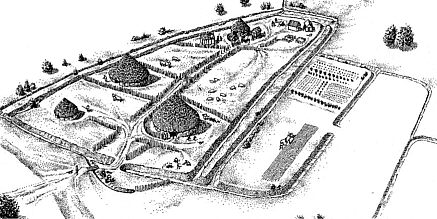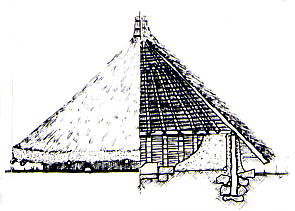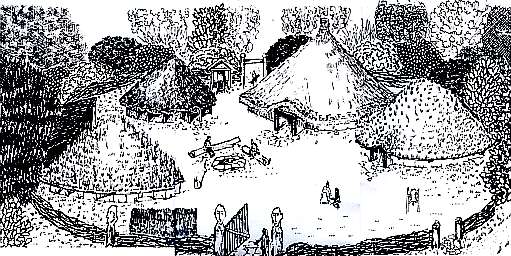Palisaded Enclosure
The centre will consist of a series of roundhouses set within a ditched and palisaded enclosure. There will be fields surrounding it, and an industrial area for iron smelting and pottery firing. The ditch, to be built similar to dimensions found during excavations of the Late Iron Age settlement at Frocester Court will be approximately three metres in width, one metre in depth. The palisade fence will be of chestnut paling construction, historically used to keep out wild animals and opportunistic raiders rather than for fortification. The entrance will be elaborated with a curved hornwork structure, made of large upright posts. Historically, this made the camp more defendable at its weakest point, and both then and now, will make the entrance more imposing to visitors. The hornwork would be approximately eight feet high, with the two posts at the entrance being larger and taller, topped with carved heads in the Celtic style.

The Early Iron Age Phase at Frocester Court, showing the hornwork elaborated entrance
The Roundhouses – Construction
There will be four roundhouses, one large (approximately fifteen metres diameter) and three smaller ones, (approximately eight metres diameter). The large roundhouse will be used to accommodate school parties and will be particularly useful in bad weather.
The aim of the Cinderbury site is to explore a number of options for building methods and construction, based on raw materials that would have been available locally in the Iron Age. Therefore, as well as the usual post/ wattle-and-daub construction, one of the roundhouses will be of drystone wall construction, and one cob-walled, to reflect the local abundance of good quality limestone and clay. Similarly, a variety of roof coverings will be tried, including reed, turf, and the Forest’s abundant bracken.

Roundhouse construction – wattle & daub (top),
drystone walls (bottom)

Comments are closed, but trackbacks and pingbacks are open.